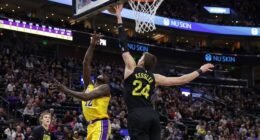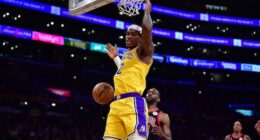
Regular Season Grade: B+
Earl Clark reminds every Lakers fan of last season’s story of Jordan Hill. They display the same energy and hustle when they are on the court, and they both took complete advantage of the opportunity of their minutes. He even worked his way onto the starting lineup in 36 of the 59 games he appeared in this season.
Clark is a decent defender, but his versatility on defense makes him unique. Growing up, Clark played the guard position so he is able to use his athleticism and speed to guard the opponents’ backcourt, and he can use his length to guard the opponents’ frontcourt.
What is a huge benefit of having “Eazy” on the court is that he doesn’t need a play drawn up for him to score. At the same time, he doesn’t need the ball in his hands to have an impact on the offense. The same thing applies on the defensive end as he is very active on the board, and uses his speed to get back in transition.
Surprisingly, Clark showcased a three-point shot that was unknown to be in his offensive tool belt. While he didn’t use his three-point shot too much during games (1.8 attempts per game), he shot 33.7 percent from downtown, which is very decent for a shot he wasn’t known to have.
However, as the season progressed, Clark appeared to have hit a wall, specifically from mid-March to early April. Clark reemerged on April 2 against Dallas, but it quickly regressed for the remainder of the season and into the postseason.
Clark finished the season averaging 7.3 points and 5.5 rebounds in 23.1 minutes per game (all career-highs). He shot 44.0 percent from the field and 33.7 percent from the three-point line.
Playoff Grade: D
The Lakers needed Clark to show up in the postseason since their roster was already depleted. Unfortunately, it didn’t happen as Clark’s diminishing contribution in the last month of the regular season spilled over to the first round.
During the postseason, Clark averaged 3.5 points and 3.0 rebounds in 20.5 minutes per game.
—- Run this town with the Laker with this awesome wallpaper! —-
Overall Grade: C+
While there is definitely a need to fine tune his game on both ends of the floor, Clark has shown great promise as a professional basketball player. He needs to work on his consistency with his jumper and with his engagement on the defensive end.
The upside to Clark’s potential is great for the Lakers. He will become an unrestricted free agent this summer, which he has already stated his desire to remain a Laker. He is willing to take less money to stay in L.A., and he has the athleticism, youth and speed that the Lakers desire in return.





